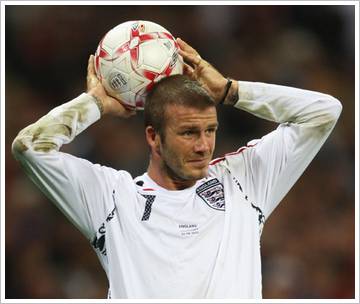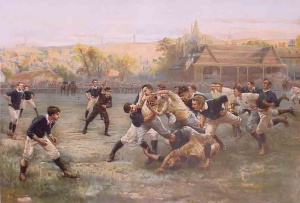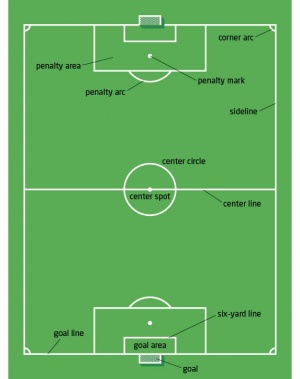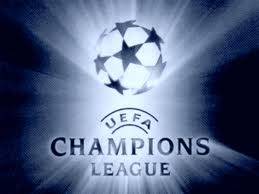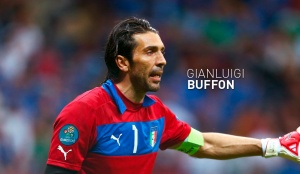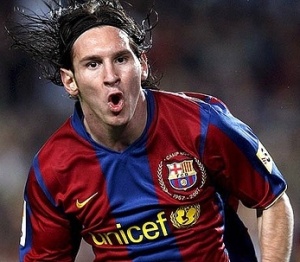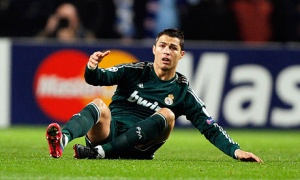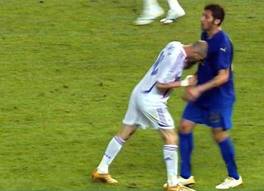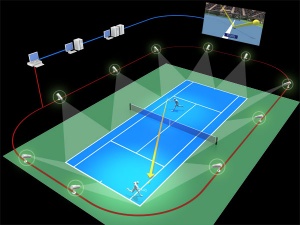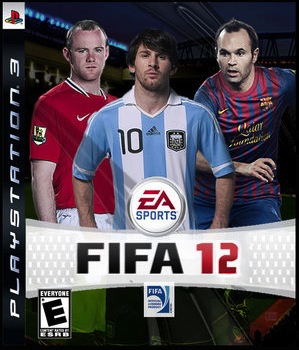Difference between revisions of "Soccer & FIFA"
(→Technology and Officiating) |
|||
| Line 104: | Line 104: | ||
[[Category:Sports]] | [[Category:Sports]] | ||
[[Category: Video Games]] | [[Category: Video Games]] | ||
| + | [[Category:GoldStar]] | ||
([[Topics|back to index]]) | ([[Topics|back to index]]) | ||
Revision as of 18:57, 13 December 2012
Soccer, better known internationally as football, is commonly recognized as the most popular team sport in the world. The idea of soccer is to score more goals than the opposing team. Each team has eleven players playing on the field at once, including a goalkeeper, who attempts to stop the opposing team from scoring. With the writing of the Cambridge Rules in 1863 to establish uniform regulations, modern soccer was born. [1] The game has subsequently spread throughout the world, as 207 countries and territories currently have Men's soccer teams recognized and ranked by FIFA. [2] Recently, multiple soccer video game series have been developed allowing users to take control of many of their favorite clubs and players. These games have often been met with critical praise and sold with much success. There are many ethical concerns surrounding both the sport itself and the video games as many larger cultural issues have manifested themselves within both aspects of the sport.
Background
Early history
Soccer, known by the rest of the world as football, originated in the 19th century in Britain. It has been played according to different rules based on the geographic location. Overall rules were very limited, and “folk” football was know as a brutal game. The first regulations of football rules date back to 1843 when University of Cambridge students attempted to standardize and codify the rules of play. In 1863, after a series of meetings of clubs from around London and close counties convened, the first written rules of football were established. The most well-known rule was set at that point, which states that carrying the ball with one's hand(s) is prohibited. In 1870 Football Association (FA) gave permission to a designated goalkeeper to handle the ball with his/her hands. [3]
Tournaments
Clubs from all over the world compete through various leagues such as the English Premier League [4], La Liga [5], Serie A [6], Bundesliga [7] and more, for league titles and league cup titles. Furthermore, the most popular soccer tournament is organized each year by UEFA (Union of European Football Associations) and is called the Champions League. This tournament was originally known as the European Champions Club’s Cup. The Champions League finale can be compared to American football's Super Bowl in terms of popularity. The best clubs from around Europe have to qualify to the tournament by going through group stages followed by knockout stages. It is a very long process and the champion is considered to be the best team in all of Europe (which is considered to be the most competitive continent for soccer). The club team that has the most wins in this prestigious competition is Spanish Real Madrid, which has nine tournament championships, followed by Italian club AC Milan, which has seven, and British club Liverpool, which has five. [8]At the international level, players compete for the FIFA [9] (Fédération Internationale de Football Association) World Cup, which takes place once every four years. The World Cup is one of the biggest sporting events in the world. The 2010 World Cup Final between Spain and the Netherlands drew over 700 million viewers. [10] in 2010. International squads must play over a four year qualification process, and 32 teams make the final cut. Brazil leads all countries with five titles with Italy having second most with four. [11] The World Cup is one of many international tournaments. Each individual soccer federation, one corresponding to each continent, also holds their own tournament, such as the Gold Cup, the UEFA European Championship, or Copa America.
Video Games
Soccer video games have become some of the best selling games in the world. The FIFA series developed by EA Sports and the Pro Evolution Soccer series, also known as Winning Eleven, developed by Konami annually compete against one another to be the best soccer video game franchise. The latest version of FIFA, FIFA 13, was released in September 2012 selling 4.5 million copies worldwide within 5 days and 7.4 million within 4 weeks, causing EA Sports to call it both "the biggest video game launch of 2012" and the "biggest sports launch of all-time." [12] The game received overwhelmingly positive reviews from critics, receiving a Metacritic rating of 90 out of 100. [13] The latest release of Pro Evolution Soccer, Pro Evolution Soccer 13, was also released in September 2012. Likewise, it received overwhelmingly positive reviews with a Metacritic score of 82 out of 100. [14]
Positions
Goalkeeper (GK)
The goalkeeper's job is to prevent the other team from scoring a goal. They are the only players that are allowed to use their hands, assuming that they are within the designated 18 yard box. Some of the best known goalkeepers in today's game include Spain's Iker Casillas, named to FIFA's FIFPro World XI as the world's best goalkeeper [15] and Italy's Gianluigi Buffon, goalkeeper for Italy's 2006 World Cup winning squad who surrendered only 2 goals in the entire tournament. [16]
Defenders
Centre-back (CB)
These defenders are crucial to a squad's defense. They are the last line of defense and the primary players that mark an opposing team's strikers. Players at these positions are usually bigger than most other players on the pitch. While there are fewer statistics to quantify a centerback's skills, Belgium's Vincent Kompany and Spain's Gerald Pique are known to be two of the world's best centerbacks. [17]
Full-back/Right-back/Left-back (FB/RB/LB/RWB/LWB)
Players in this position are located wide of the CB's, and focus on shutting down crosses into the penalty area where an opposing striker may be to head a ball or to close off wide play by opposing wings. These players are usually smaller, faster defenders who can track the opposition's speedy wingers, or even advance up the field to support their own team's attacking play. England's Ashley Cole, known for his attacking play and currently has played in the most games ever for England's National Team, is considered one of the world's best leftbacks. [18] On the other side of the pitch, Brazil's Dani Alves is known as one of the best attacking fullbacks in the world because of his speed and ability to cross the ball into the box. [19]
Midfielders (DM/AM/CAM/CDM)
Midfielders take on both offensive and defensive responsibilities, and tend to do a lot of running up and down the pitch. Depending on their role, some are used as scoring threats in tandem with a team's strikers or as an extra line of defense. Whichever role they specialize in, midfielders must have top-notch vision of the pitch and passing skills to thrive in the midfield, between the attacking and defending zones. England's Frank Lampard, the highest scoring midfielder in the English Premier League since its establishment in 1992, is renowned for his all-around skill as a "clinical finisher, proficient tackler, and gifted passer." [20]
Forwards (CF/LW/RW/ST)
Also known as strikers depending on their roles, this position consists of players who are mainly focused on attacking the opposing team's net and scoring goals. Throughout the years, several players have come and gone in the sport and have made their mark on history. Oftentimes, forwards are the most well-known players due to their tendency to score more often than players at other positions. Today, Lionel Messi and Cristiano Ronaldo (Real Madrid) are regarded as two of the best players of this generation, racking up an impressive list of awards and honors during their careers in the game. Ronaldo won the FIFA player of the year award in 2008 and Messi won the award in 2009, 2010, and 2011. [21]
Soccer Terminology
- Corner Kick: The opposing team's kick on the corner of the defending team when the ball passed over the goal line by the defending team.
- Goal Kick: The goalkeeper's kick when the ball passed over the goal line by the opposing team.
- Punt: When the goalkeeper saves a ball, he can drop kick it far to the other players on the team.
- Kick-Off: The start of each period and after a goal.
- Free Kick: A kick that is issued to the fouled team everywhere on the field besides opposite sides’ penalty area.
- Penalty Kick: A kick that is issued to the fouled team in the penalty area.
- Throw-In: The throw of the ball when the ball passed over the sidelines. One variation is when a player does a flip throw in where the player performs a somersault before throwing the ball into play.
- Red Card: Player misconduct determined to be the most severe by the referee. The red-carded player is ejected from the game and his team must finish the match without another player to replace him.
- Yellow Card: A caution put upon a player by the referee for the player's misconduct. Two yellow cards leads to a red card.
Ethical Concerns
The most popular sport in the world is surrounded by controversies, foul play, cheating, and more. This happens through fixing of matches, taunting during play and through different cheap shots taken in several exhibition games. It is also present in the virtual world of gaming through online taunting through voice messages, text messages and the ever-popular user celebrations that ignite gamers' tempers.
Real Life
Racism
One major issue in the modern game is racism against different ethnicities. Racism is particularly visible in soccer because of the wide range of countries from which the players are from. In a single club team, there could be tens of different countries represented. FIFA has been campaigning strongly to "kick racism out of football," pitching this popular slogan in all areas of the game. [22]. Recent developments have seen many different players fined large amounts of money and/or suspended from playing in games due to their actions being determined to be racist. In one major case, John Terry, former captain of England's National Football Team, was fined £220,000 by England's Football Association and suspended for 4 games in October 2012 for racially abusing fellow soccer player Anton Ferdinand during a match in 2011. [23] Soccer has also suffered from many problems with racist fans. In countries such as Italy, Spain, Poland, and Bulgaria, as well as others, there have been instances of monkey chants towards black players, bananas being thrown at them, as well as Nazi salutes. [24] [25] Back in 2009, Italian soccer club Juventus was ordered to play a match against Internazionale behind closed doors, with no fan support, in response to racist actions against outspoken and controversial soccer star Mario Balotelli. [26]
Fixed Matches
The sport is victim to match fixing through the bribing of referees, managers and players. Certain positions are easier to utilize in order to swing games such as a midfield player using poor midfield passing leading to ball turnovers or paying the goalkeepers to let goals get by them.
Fouls/Penalties
During matches, emotions run high as squads battle for positions in their leagues, trophies and bragging rights among rivals. One of the most memorable instances of foul play was during the 2006 World Cup final when Zinedine Zidane of France headbutted Marco Materazzi of Italy in the chest after Materazzi insulted his sister. [27] FIFA rules state that fouls are to be called for kicking, tripping, jumping at, striking, pushing, or tackling another player in a "careless, reckless" manner or one that uses "excessive force." [28].
Flopping, or feigning injury, has also become a regular aspect in professional soccer matches, usually performed with the intent of drawing penalties or fouls against the other team. FIFA VP Jim Boyce called the ongoing practice "a little bit of a cancer within the game" and described a specific instance that was "nothing less than a form of cheating." [29] This has caused many soccer fans to push for more strict rules regarding flopping to further discourage players from participating in such behavior. [30] Fans have argued that this has a negative effect on the game this has taken of soccer as it delays the game and also causes confusion as to whether the player has actually sustained an injury. Often times, flopping is performed near the end of matches when a team is clinging onto a narrow lead in an attempt to waste the opponent's time and thus their chances to score.
Technology and Officiating
In the 2010 World Cup, England had an apparent goal against Germany to tie the match. However, the linesman did not see the ball cross the goal line and Germany held onto its 2-1 lead. In response to miscalls like these, FIFA has determined to invest in goal detection systems which would inform the referee if the ball fully crosses the goal line. FIFA has various tests that any system must complete [31], but if a system is certified, soccer will begin taking the path that many other professional sports have of implementing technology to aid officials such as football video reviews and tennis's Hawk-Eye
As of the summer 2012, FIFA will start using goal-line technology. The Hawk-Eye technology, along with the GoalRef technology is planned to be in use during the Club World Cup in Japan and during the Confederations Cup in Brazil next year. These new technologies will hopefully provide the correct concrete judgment over disputed goals, as human error will not be present in such decisions. The develops the ethical concerns with the authenticity of the game, which human judgment and error contribute to the experience of each game, and the correct calls from referees. Fans and officials are skeptical of introducing such technology, very similar to such sports like the NBA and MLB, in the game as it’s looked upon as just a stepping-stone to have electronic regulations of the game play because with electronic refereeing, there would be consistent correct calls. But there would be no leeway in calls, which human judgment has and will always have the ability to do. Fifa had to finally respond with a solution to many tournament and World Cup disputed goals.
- The Hawk-Eye system will have six cameras loacted in each corresponding goal tracking the ball’s movements. Through finding the position of the ball through the cameras, a secure radio signal will be sent to the main referee to signify when the ball crosses the line. This technology has been in successful use by professional cricket and tennis tournaments. [32]
- The GoalRef system is designed to signify the referee when the ball crosses the line through an embedded chip in the ball and the communication of the chip to sensors that are located in the goals. This might be the most likely choice for future installments of goal-line technology as it’s supposed to be less expensive to install compared to the Hawk-Eye.[32]
Soccer, Gender and Mass Media
The mass media often focuses on the social construction of women's sports. One of the most famous examples is Brandi Chastain, who became a soccer sensation. Her most notable act, as presented by mass media, was ripping off her shirt to reveal her sports bra on the playing field after a win. Instead of focusing on her skills and role as an athlete, news outlets consistently praised Chastain as the "girl who took off her shirt". [33] Although mention of her athletic abilities came into play, the focus laid in her unexpected action, which some considered to be deviant "female" behavior.
This is one example of sexism commonly found throughout the sports world, including soccer. Sports tend to emphasize traits that are typically considered masculine which leads men to be considered more athletic than women and men's sports to be garner significantly bigger live and television views than women's.[34] In the United States, player's on the United States Women's National Team make on average $25,000 a year, while the average player in the United States' Major League Soccer makes an average of $32,000 a year. While a new professional league is scheduled for play in 2013, two previous attempts at the creation of a women's professional soccer league in the United States have folded in 2003 and 2011 after 3 seasons of play each. [35] Meanwhile, Major League Soccer, the professional men's league in the United States has existed in its current form since 1996 and has continued to grow in popularity and profitability in recent years. [36]
Video Games
Taunting
In any online gaming situation, the presence of chat rooms, forums, and voice communication enhances gameplay but also leads to online bullying through name-calling and other forms of trash talking or harassment. Online games are fairly anonymous, as players identities are linked only to a name of the player's choosing and not to his real-world identity. Though these actions go against the terms of use of the game systems [37], there are usually minimal to no consequences of any single act of harassment or bullying. In fact, this kind of behavior might even be encouraged, as it could distract the person being abused and give the user committing the harassment an advantage in the game.
User Celebrations
After a user scores a goal, he or she can perform celebrations based on certain combinations of buttons they press. This can be used as a source of displaying joy and satisfaction, but it can also serve as a potential way to insult opponents. It can either lighten the mood of all the players or it can become a source of frustration. For instance, most of the celebrations available are replicas of celebrations that real soccer players have performed during real matches. So, users enjoy reenacting those situations by performing such celebrations. However, if it is performed in a taunting manner or if the intention is not appropriate, then it can be used to insult the opponent. Many times this can lead to heightened tempers which compromises the quality of the game or competition and forces players to play with the wrong frame of mind.
Cheating
Another ethical concern for FIFA and other soccer or sports-related video games is the problem of cheating. Cheating can be accomplished in a number of ways in a virtual environment, depending on the user's ideas of what is ethical and moral. For example, if a user utilizes a "created player" with higher skills rating on his or her team, then the user could be gaining an unfair advantage over his opponent. Depending on the user's preferences, the opponent could be another person playing the game or a Central Processing Unit (CPU), the Artificial Intelligence and Technology of the game's programming providing a virtual opponent for the user. Online Cheating could also be defined as the process of changing the game's controls to make it easier for inexperienced users to better compete against more advanced game-players. This is called FIFA Custom Tactics. These Custom Tactics can can "give [users] a whole new FIFA experience and can help...less skilled FIFA [players] beat...higher skilled [opponents]." [38] Users have to grapple with the morality of such actions, as well as the possible differences in cheating against the CPU versus cheating against a human opponent.
See Also
References
- ↑ "Classic Football, FIFA.com
- ↑ "FIFA/Coca-Cola World Ranking" , FIFA.com
- ↑ "Football.", Britannica.
- ↑ Premier League, Official Site
- ↑ La Liga, Official Site
- ↑ Serie A, Official Site
- ↑ Bundesliga, Official Site
- ↑ UEFA Champions League, Wikipedia
- ↑ FIFA, Official Site
- ↑ "FIFA: Over 700m viewers for World Cup final.", Sports Business. [
- ↑ "FIFA World Cup", FIFA.com
- ↑ Jackson, Mike. "FIFA 13 sales hit 7.4 million in four weeks.", ComputerAndVideoGames
- ↑ FIFA 13, Metacritic
- ↑ "Pro Evolution Soccer 13, Metacritic
- ↑ "FIFA/FIFPro World XI." FIFA.com. <http://www.fifa.com/ballondor/world11/index.html>
- ↑ "Gianluigi Buffon." ESPN Soccernet. <http://soccernet.espn.go.com/player/_/id/12947/gianluigi-buffon?cc=5901>
- ↑ "World Power Rankings: Top centerbacks." Fox Soccer. <http://msn.foxsports.com/foxsoccer/world/lists/top-ten-centerbacks-defenders-world-football-soccer-070312#tab=photo-title=Gerard+Pique%252C+Barcelona%252FSpain&photo=31176197>
- ↑ "World Power Rankings: Top left backs." Fox Soccer. <http://msn.foxsports.com/foxsoccer/world/lists/power-rankings-top-ten-left-backs-world-soccer-professional-club-international-070512#tab=photo-title=Patrice+Evra%252C+Manchester+United%252FFrance&photo=31176749>
- ↑ "World Power Rankings: Top right backs." Fox Soccer. <http://msn.foxsports.com/foxsoccer/world/lists/top-ten-right-backs-world-football-soccer-football-070412#tab=photo-title=Daniel+Alves%252C+Barcelona%252FBrazil&photo=31177207>
- ↑ Coggin, Steward. "Frank Lampard." World Soccer. About.com. <http://worldsoccer.about.com/od/players/p/Frank-Lampard.htm>
- ↑ "Ballon d'Or." FIFA.com. <http://www.fifa.com/ballondor/archive/index.html>
- ↑ "Let's Kick Racism Out of Football." <http://www.kickitout.org/1.php>
- ↑ Sale, Charles. "One year on, Terry FINALLY says sorry for racist abuse...as he misses games with Rio AND special Kick It Out campaign." Mail Online. <http://www.dailymail.co.uk/sport/football/article-2219171/John-Terry-says-sorry-racist-abuse-Anton-Ferdinand.html>
- ↑ Longman, Jere. "Racism and Soccer Are in Play at a Big Event in East Europe" The New York Times. <http://www.nytimes.com/2012/05/31/sports/soccer/concerns-of-racism-precede-european-soccer-championships.html?pagewanted=all>
- ↑ "Racism at Italian Soccer Matches." ABC News.<http://abcnews.go.com/WNT/story?id=130886&page=1#.UMJgAHdzKog>
- ↑ http://www.independent.co.uk/sport/football/european/juventus-must-play-game-behind-closed-doors-1671543.html
- ↑ Stevenson, Jonathan. "Italy beat France 5-3 in a penalty shoot-out to win the World Cup after an absorbing 1-1 draw in Berlin." BBC Sport. <http://news.bbc.co.uk/sport2/hi/football/world_cup_2006/4991652.stm>
- ↑ "Laws of the Game". FIFA. <http://www.fifa.com/mm/document/affederation/generic/81/42/36/lawsofthegame_2012_e.pdf>
- ↑ "FIFA VP calls diving a 'cancer'" ESPN. <http://soccernet.espn.go.com/news/story/_/id/1185527/fifa-vp-jim-boyce-says-soccer-must-eliminate-diving-%27cancer%27?cc=5901>
- ↑ Torres, Cesar R. "On Diving: Soccer’s Integrity Is at Stake" Goal: The New York Times Soccer Blog. <http://goal.blogs.nytimes.com/2009/09/17/on-diving-soccers-integrity-is-at-stake/>
- ↑ Malinowski EriK. (2011). FIFA Eyes 2012 for Goal-Line Tech Implementation. Playbook.
- ↑ 32.0 32.1 Soccer to Adopt Goal-Line Technology, Jack Bell, 5 July 2012 nytimes.com
- ↑ Chastain Lifts Sports Apparel Market <http://www.washingtonpost.com/wp-srv/sports/soccer/longterm/worldcup99/articles/sportsbra14.htm>
- ↑ Seepersaud, Steve. "Female Athlete Salaries." AskMen. <http://ca.askmen.com/sports/business_150/190_sports_business.html>
- ↑ Whiteside, Kelly. "Women's pro soccer league to debut in U.S. next year". USA Today. <http://www.usatoday.com/story/sports/soccer/2012/11/21/new-womens-soccer-league-to-debut-next-year/1720343/>
- ↑ Baxter, Kevin. "MLS steadily builds toward goal of profitability." The Los Angeles Times. <http://articles.latimes.com/2011/nov/18/sports/la-sp-mls-finances-20111119>
- ↑ "Reporting Abuse on Xbox Live." Xbox.com. <http://www.xbox.com/en-US/live/abuse>
- ↑ "FIFA Custom Tactics." FIFAAddiction.com <http://fifaaddiction.com/tutorials/tactics/>
